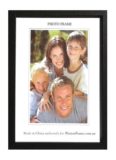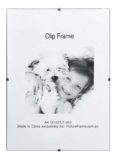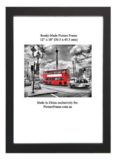Most Customers with an interest or passion in home décor, and more particularly, the picture framing an d display of art on paper, such as photos, prints, posters and the like, will probably already know what is a window mat (or window mount or passé-partout as it is known in Europe) when researching window mat designs . However for those who may not be fine art aficionados, a window mat is paper or cardboard edge one often sees around many of the nicer photos or images. It creates a separate field of colour, definition and light, between the picture frame and the art itself. More prosaically, it keeps the glass off and away from touching the artitself, always a good thing, so far as its preservation, protection and conservation are concerned. Most of the time it is white, off-white or whitish, but it can be black, or of any colour, for that matter. The mat can be a mass-produced item or individually crafted, often by a custom picture framer for a custom picture frame. Historically, a window mount, with or without a backing board was created to enhance artists’ most common method of expressing their art, drawings.
d display of art on paper, such as photos, prints, posters and the like, will probably already know what is a window mat (or window mount or passé-partout as it is known in Europe) when researching window mat designs . However for those who may not be fine art aficionados, a window mat is paper or cardboard edge one often sees around many of the nicer photos or images. It creates a separate field of colour, definition and light, between the picture frame and the art itself. More prosaically, it keeps the glass off and away from touching the artitself, always a good thing, so far as its preservation, protection and conservation are concerned. Most of the time it is white, off-white or whitish, but it can be black, or of any colour, for that matter. The mat can be a mass-produced item or individually crafted, often by a custom picture framer for a custom picture frame. Historically, a window mount, with or without a backing board was created to enhance artists’ most common method of expressing their art, drawings.
Mats and window mat designs were deemed aesthetic continuations and developments of the creation of artists. The mount not only enhanced the drawing but was seen as an extension of the creative process of the artist or the collector. For centuries made from leather, metal, gilt or wood, paper window mats with bevelled openings became in vogue during the flourishing of the arts in aristocratic England and Europe with the Roman-inspired Neoclassicism and the later, emotionally-inspired Romantic movement.
The industrial revolution inventions with the betterment of glass quality, and the gradual adoption of the Stanhope press and Koenig printing presses, both greatly increase the availability of art on paper and lowered its acquisition barrier, thus making this medium much more popular than it had ever been. Prior to mechanization, print imagery had a transient and ephemeral usage being nailed or tacked to dwellings and replaced only when the print became too faded, soiled, torn, or dilapidated. This boom in printed art saw new window mat designs and matting increase in popularity and greater experimentation in colours, formats and sizes.
Coincidentally, the wider width window mat bottom, with a bigger, or “heavier” lower section, appeared at around this time. It has been theorized that this was because picture frames were hung rather high along walls and it was thought that it the picture frame was mounted lower, the bottom border would look narrow and out or proportion. Part of this design experimentation was the silvering and gilding initially, later the silk and other fabrics, covering of mounts, fashion trends long since discontinued.
The First World War brutalized both humanity and art, window mat designs withered and the window mat toned down to that plain unadorned look we are familiar with nowadays. Nevertheless mats are still carefully selected to compliment the colour and proportion of the art being framed not only to enhance its appearance, but also to assist the beholder’s view to focus to the core of the picture frame, or the art being displayed. Aside from its appearance, mat boards used for matting can vary greatly in their construction and proffers many other technical aspects, some of which alluded to earlier in this post.
They also have recognized status and hierarchy, condensed as follows: a) Museum Quality, b) Rag Mat Quality, c) Conservation or Archival Quality and, d) Acid-Free Quality. Further elaboration is beyond the scope of this post but further reading can be found in our page "Picture Frames and Picture Framing Standards". Lastly, most mats are nowadays production mats, cut by computerized mat cutters. The machines cut mats much more quickly than by hand, and with a far higher degree of accuracy, virtually elimination all errors, undercuts and overcuts, the bane of a picture framer.
The U.S. made “Wizard” is one of the most popular machines, because of its robustness, durability and excellent software. One last point, a window mat’s aperture, or opening, is always cut a few millimetres smaller than the art which it will cover and surrounds. Ergo, if the art is A4, to wit, 210x297mm, a framer will most likely cut the opening around 202 x 291mm. This simple adjustment will prevent the art from falling out of the hole just cut, because the A4 paper is now too big to come out.
Option 1) Now let’s illustrate some mat designs and variations by first reviewing the image below . The rather evocative image is simply framed with a black frame. Visually, it barely does the job, so to speak. The arrangement does nothing to separate the art from the frame which, in places, blends and merges with the trees. Aesthetically, the frame attracts a lot of attention to itself and partially distracts us from fully appreciating the art inside.

Option 2) Now, here’s the same image framed with a centred, single window mat having for equal sides. All sides are about 75 mm wide, the most commonly used width and by far, the most popular composition. It proffers a simple, unencumbered display of the art being framed which now “speaks” for itself without being hemmed in by the frame.

Option 3) This, in essence, the same arrangement as the preceding one. It varies only by the mat widths being 100mm instead of 75mm. This option makes for a larger picture frame and it is often requested by Customers which may have large walls to fill. Because of this it is a slightly more expensive option since more linear and square measurements quantities are used.

Option 4) This option is very similar to the previous one, No.3. The width of the mat is 50mm instead of the standard 75mm. It is generally felt that this picture framing composition proffers too small a mat and that a wider one would suit better. However there are some Customers who ask for and prefer this format because a) they like it and b) they want to keep the overall size of the frame small.

Option 5) The window mat below is pretty much a standard size window mat but with the bottom section larger, wider, or “heavier”. For this reason it’s often called a “heavy bottom“ or “ weighted bottom “ or “bottom-heavy” or “ bottom offset” mat. This simply means what the mat books, and that is, with the lower edge, or section, bigger than the other three. Why do Customers want and ask for this is more complicated.
Science suggest that this is because our optical centre is a little higher than a rectangle’ true geometric centre, hence the correction. However some Customers say that they want this construction because they thought that all pictures were framed that way, with a strong foundation, like a house. Others say that they prefer it because it raises the art’s horizon in the beholder’s eyes and enhances perception and appreciation.
And quite a few say that they want such a mat because it will meet the “Golden Mean”. We call this by another name, the Golden though it’s essentially the same construct. Rather than iterate existing information, please visit “The Window Mat Golden Ratio Explained” to delve into this fascination topic further.

Option 6) Yet another option are double, triple ( not shown) or more mats. These are window mats cut in slight smaller opening sizes and mounted, or stacked, on top of one another. In the photograph below, a black window mat surrounds the image, and on top of it is the white mat, cut with little wider opening so as to reveal a sliver of the black mat under it. By liver we mean just shown a thin border, typically 5mm, but can by more or less, depending on what a Customer may specify.
Multiple mat add both a visual and a physical depth and are sometimes specified for team sports colours such as red, white and black for St. Kilda football memorabilia. These cost more of course as there is more labour and extra matting materials are required, perhaps 30%to 50% more that a single mat job.

Option 7) Yet another, though uncommon, option is the Museum Mat Board example shown under here. It has a large top and sides with a considerable larger lower section. It is thus named because many museums typically use this format to display works on paper such as etchings, watercolours, engravings, drawings, etc. And just as often, galleries and museums tend to use, off-white, pale mat board colours for these mats. It is rarely requested by private Customers, or made for ordinary, custom picture framing jobs.

Option 8) The window mount below is often called an Asian, Eastern or Oriental mat. These are proportioned to imitate Chinese hanging scrolls Yisebiao, Ersebiao , Sansebiao, Japanese Kakemono, kakejiku and kindred Asian scroll art. The dimensions are fairly traditional, with the sides typically being 1/8th or 1/3rd than the top and bottom sides. While its application is most often associated with oriental pieces, it can look appealing with any elongated, portrait art.

Option 9) This last format is rare and hardly ever seen but we have done a couple, by special request, and that’s probably why we remember it. It was called it a print window mat and we were instructed to cut it as illustrated below, with the top and bottom sized much narrower than the other adjacent sides. Conversing with the Customer, a retired printer, we were told that this format derived from the custom of printers printing limited edition art on larger-than-normal paper so as not cut or trim anything, even if the edition, etching or lithograph was printed misaligned.










Amazing how a simple band of white around an image can make so much of a difference! I’ve just started graphic design from a very late career change and now I can see why picture framers tend to always suggest adding a window mat when I want a picture framed. Sure, there’s the added cost to be factored in, but the finished result is often well worth the relatively greater expense. I guess that’s the difference between a cheap-looking department store poster frame and an elegant, stylish, custom-made picture frame.